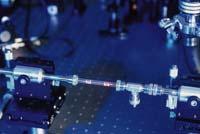Cooling a solid with laser

A team of researchers from the University of the Basque Country has managed to cool with laser the materials doped with vertigo ions. The work of the group led by Joaquín Fernández has been published in the journal Physical Review Letters.
This phenomenon, known as optical cooling, has attracted great interest in the last two decades, especially in the field of gases. However, the cooling of solid substances by using laser beams is much more difficult and, in fact, doped material types have been reduced in the laboratory. (Doped material is called those materials to which a small ion concentration of another element has been added.)
The vertex is a metallic element with the particularity that when its ion hits the lights of a certain wavelength, they are able to increase that wavelength of light.
In the research carried out by scientists of the UPV-EHU the light emission of the vertex has been used to cool the material in which these ions are found. This discovery is important, on the one hand, for technical difficulties and, on the other, because optical cooling based on materials doped with the vertex occurs in wavelengths and powers similar to those of conventional diode lasers. Therefore, these materials are ideal for possible applications. Applications include high-power fiber optic lasers, laser-based medical diagnostic techniques (optical tomography) and phototherapy.
These devices will have two laser beams: one of the wavelengths would be used to perform its proper function and the other, next to the other, to produce optical cooling to match the heating caused by the laser. In fact, heating has some negative effects, as it can modify the properties of the material being used and even burn it.





